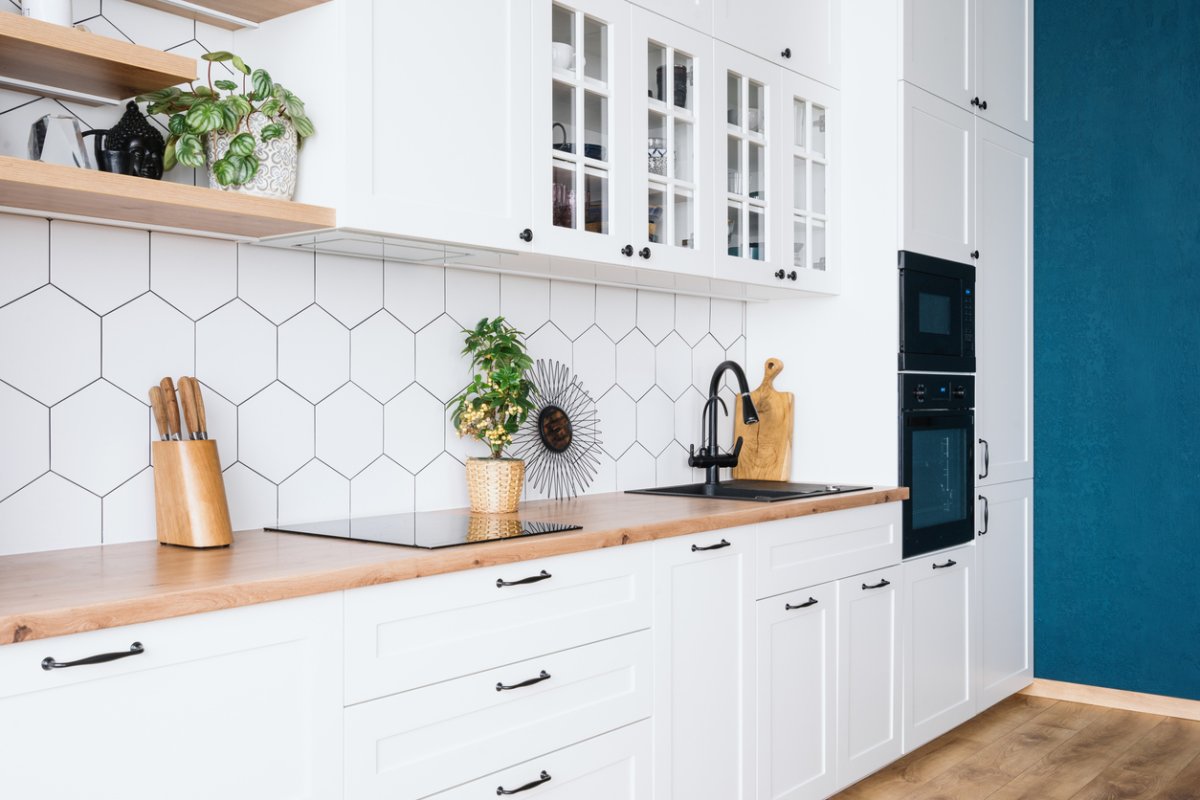

We may earn revenue from the products available on this page and participate in affiliate programs. Learn More ›
The term “custom kitchen” is a favorite among remodelers, realtors, and even proud DIYers. But, the truth is that many custom kitchens are actually a collection of standard and off-the-shelf building products like kitchen cabinets.
Standard kitchen cabinet sizes—along with standard sizes of appliances, doors, windows, countertops, and other fixtures—are built to ensure that all of the puzzle pieces fit together perfectly. So, it’s helpful that only a few standard sizes exist for base, upper, and full-length cabinets.
This guide explains the different standard sizes to help make planning a kitchen renovation that much easier.
RELATED: 10 Kitchen Cabinet Styles to Consider for Your Next Renovation
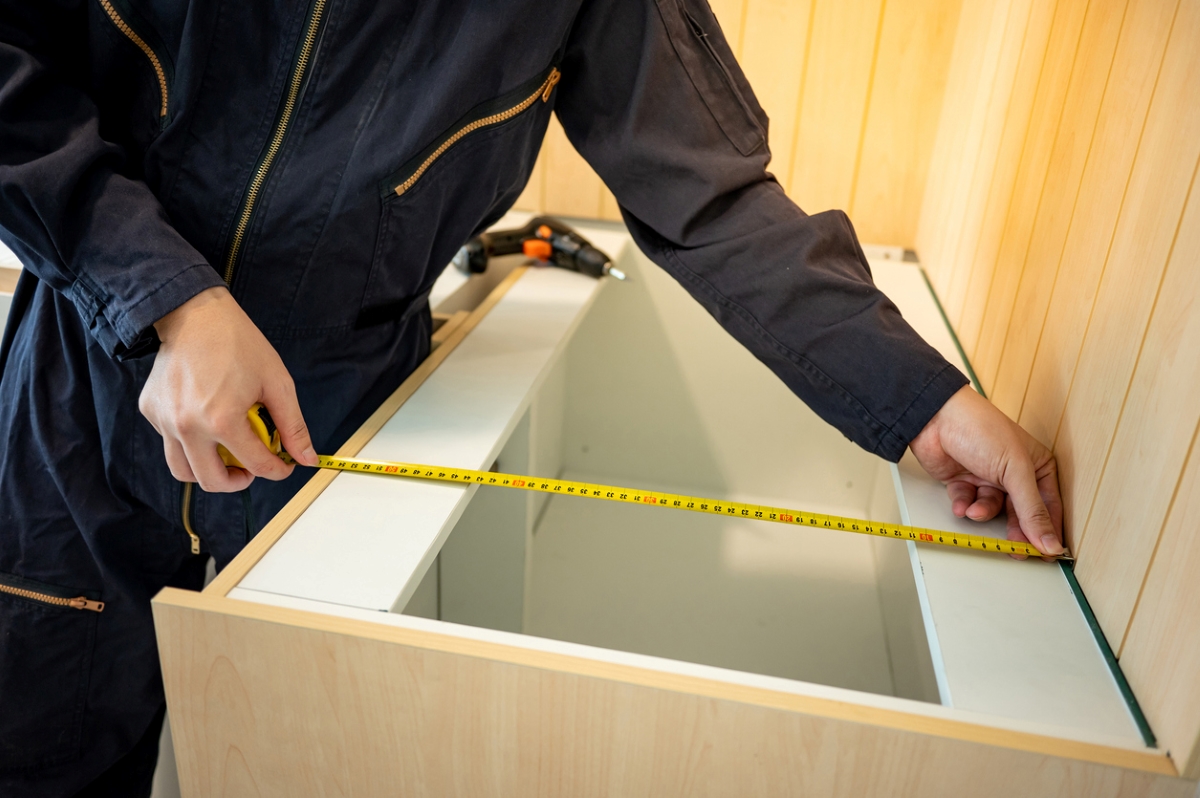
How to Measure Cabinets
Measuring kitchen cabinet dimensions is quite easy, but it’s important to know how to do it before shopping for cabinets.
Kitchen cabinets are measured across their fronts (width), from top to bottom (height), and front to back (depth). These measurements matter because they help plan the kitchen layout and ensure that countertops, appliances, and other features fit together nicely and provide a finished look.
- For width, measure across the front of the cabinet from side to side. Many cabinets have face frames that extend slightly past the cabinet itself, so it’s important to measure across the front for accuracy.
- For height, measure from the bottom of the cabinet to the top, not counting countertops.
- For depth, place the tape measure on the side of the cabinet and hook it onto the back. Pull the tape all the way to the front of the cabinet, taking the measurement at the front of the face frame.
Note: Some cabinets do not have face frames. These are usually called “frameless” or “European style.” Measure them the same way as cabinets with face frames, as they typically come in the same standard cabinet sizes.
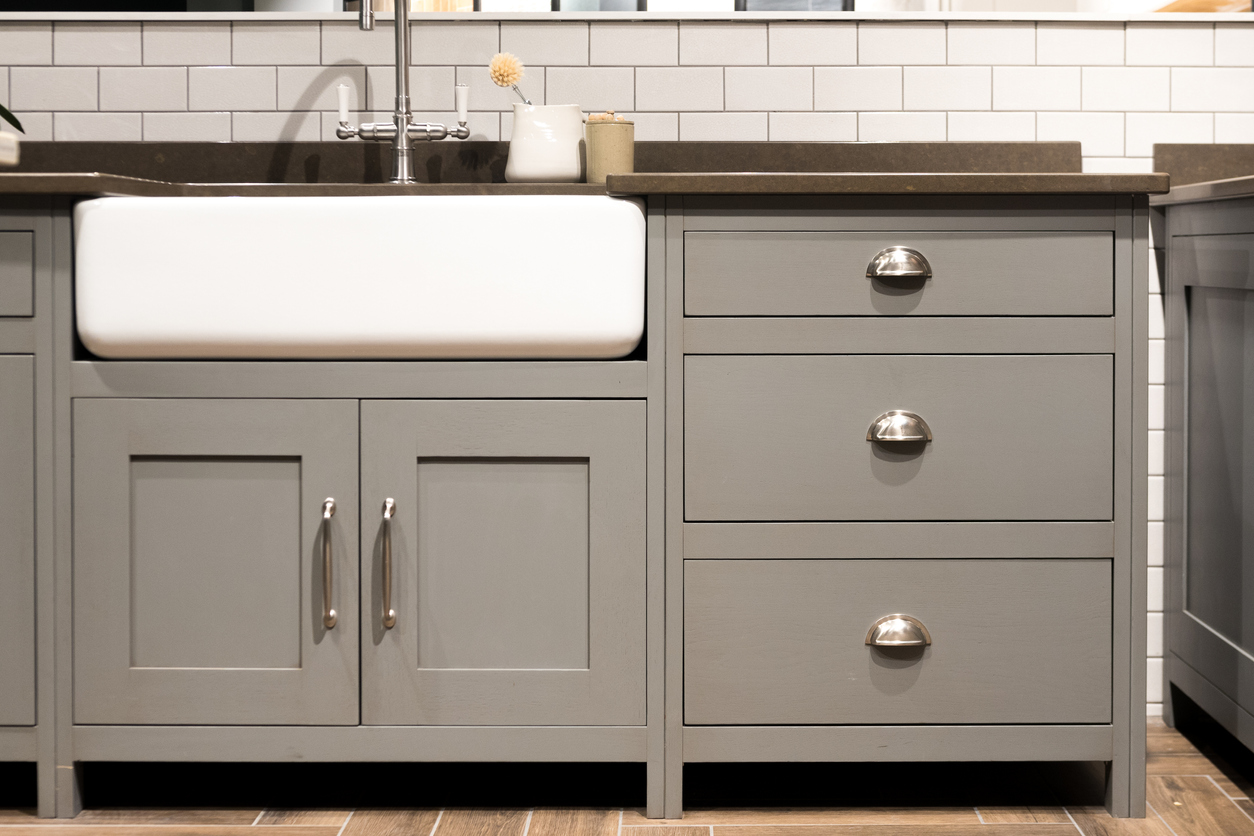
Base Cabinet Height, Depth, and Width
As the name suggests, base cabinets are under the countertops, and they’re what the rest of the kitchen’s cabinets are essentially based on. They’re also known as lower cabinets, and many DIYers think of them as floor cabinets.
In bathrooms, they’re often used as vanities, and in kitchens, they can be used along the walls or turned into islands or L-shaped peninsulas. They come in variations with drawers, doors, and turntables, or a mixture of features.
Because so much rides (or sits, essentially) on these cabinets, it’s important that they’re properly matched in height and their width makes sense for the layout. The following are some of the most common heights, depths, and widths for base cabinets.
Standard Base Cabinet Height
The standard base cabinet height is 34½ inches. If a DIYer were to head to their local home center, they’ll find that all of the cabinets are this tall. With a finished countertop installed, this brings the overall height to between 35 and 36 inches, which is comfortable for most folks for preparing food, washing dishes, and other typical kitchen activities. Also, this standard kitchen cabinet height determines the design of most appliances (dishwashers, under-counter wine coolers, and stoves).
That said, it’s important to note that accessibility does come into play. Folks who are shorter in stature and those in wheelchairs may require base cabinets that are lower to the ground. In these cases, base cabinets can be 30 to 32 inches high. Also, for islands, coffee bars, or simply visual interest, they can also reach as high as 38 inches.
Standard Base Cabinet Depth
For the same reasons as above (appliances and uniformity), base cabinets generally come in one standard cabinet depth, and that’s 24 inches. This is the standard kitchen cabinet depth because it’s shallow enough that reaching items at the back of the counter isn’t an issue for an average adult, but it still provides enough workspace and storage inside the cabinet.
That’s not to say that countertops are 24 inches deep. Most designs call for an overhang of up to 2 inches over the front of the cabinet, as well as a backsplash at the back of the counter. This usually brings a finished counter’s depth to around 25 inches, making a 24-inch base cabinet depth the ideal size.
For special designs (such as the backside of a kitchen island), base cabinets of 12, 15, or 18 inches in depth may be available from some manufacturers.
Standard Base Cabinet Width
While height and depth are usually pretty consistent, base cabinets can come in a lot of standard cabinet widths. In general, base cabinets come in widths between 12 and 60 inches, and they’re usually available in 3-inch increments within that range. So, standard base cabinet sizes are usually 12, 15, 18, 21, 24, 27, 30, 33, 36, 39, 42, 45, 48, 51, 54, 57, and 60 inches.
However, within that range, some sizes are more common than others. Sizes such as 12, 18, 24, 30, and 36 inches are the most common in kitchens. Vanities that are 36 and 48 inches wide are also common in bathrooms. The in-between sizes are standard, but not nearly as common and available off-the-shelf.
Use the following short list of standard kitchen cabinet sizes as a helpful width reference:
- Cabinets under 24 inches are typically filler cabinets or specialty cabinets for spices or other miscellaneous items.
- Single sinks usually fit best in 30-inch-wide cabinets.
- Double sinks are best in 36-inch-wide cabinets.
- 48-inch-wide cabinets are most common as bathroom vanities.
RELATED: 20 Reasons Why Two-Tone Kitchen Cabinets Are Still Trendy
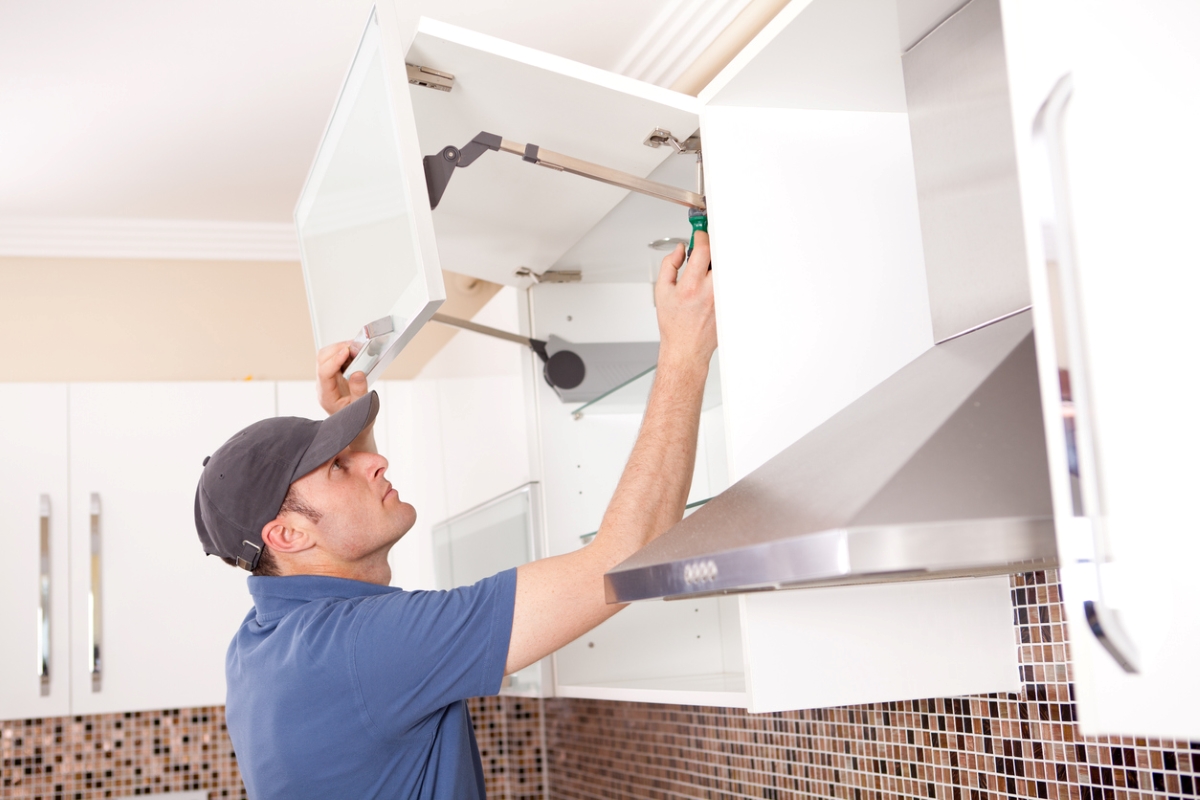
Wall Cabinet Height, Depth, and Width
Wall cabinets are the boxes that are installed above the countertop, and not surprisingly, attached to the wall. These cabinets are also known as upper cabinets, though there isn’t a rule stating they must be installed above a countertop. They can be installed as floating base cabinets and used as shallow coffee bars and for other purposes, but designs don’t usually call for installing these cabinets directly on the floor.
While their overall heights can vary widely, their installation height is generally about 18 inches above the standard base cabinet and countertop, or 54 inches from the ground. In most cases, this is a height that the average person can easily reach, though taller cabinets might store some items out of arm’s reach. The main exception to this rule is over a stove, where they’re usually 24 inches or more above the range.
The following will explain some of the most common heights, depths, and widths of upper cabinets.
Standard Wall Cabinet Height
There are no rules as to which kitchen cabinet heights to use, as the most limiting factors are design and ceiling height. However, standard sizes for upper cabinet height include 12, 18, 30, and 36 inches high. Either 12- or 18-inch cabinets are generally used over stoves, while 30- and 36-inch cabinets are typically installed along the walls over the countertops.
It’s worth noting that those aren’t the only standard kitchen cabinet heights. Both 42- and 48-inch cabinets are also available, and they’re best for kitchens with tall ceilings.
Standard Wall Cabinet Depth
While heights and widths vary a bit, upper cabinet depth is generally pretty standard. They’re most commonly 12 inches deep, but some can be as deep as 18 inches when they are designed to be placed over the top of a microwave or stove and even 24 inches deep over a fridge.
These depths allow for enough storage while still allowing people to “belly-up” to the counter for food prep without hitting their heads.
Standard Wall Cabinet Width
Standard wall cabinet widths are usually 12, 18, 24, 30, and 36 inches. Cabinets much wider than 36 inches might not be able to carry the load of all the items that can fit inside, causing them to warp or break.
Wall cabinets generally match the base cabinets underneath them by dividing the width into one, two, or three sections. For example, a 36-inch base cabinet might have one 36-inch upper cabinet with two doors or two 18-inch cabinets with a door each. A larger 48-inch cabinet might include two 24-inch cabinets or one 24-inch center cabinet flanked by two 12-inch cabinets, depending on what the design calls for.
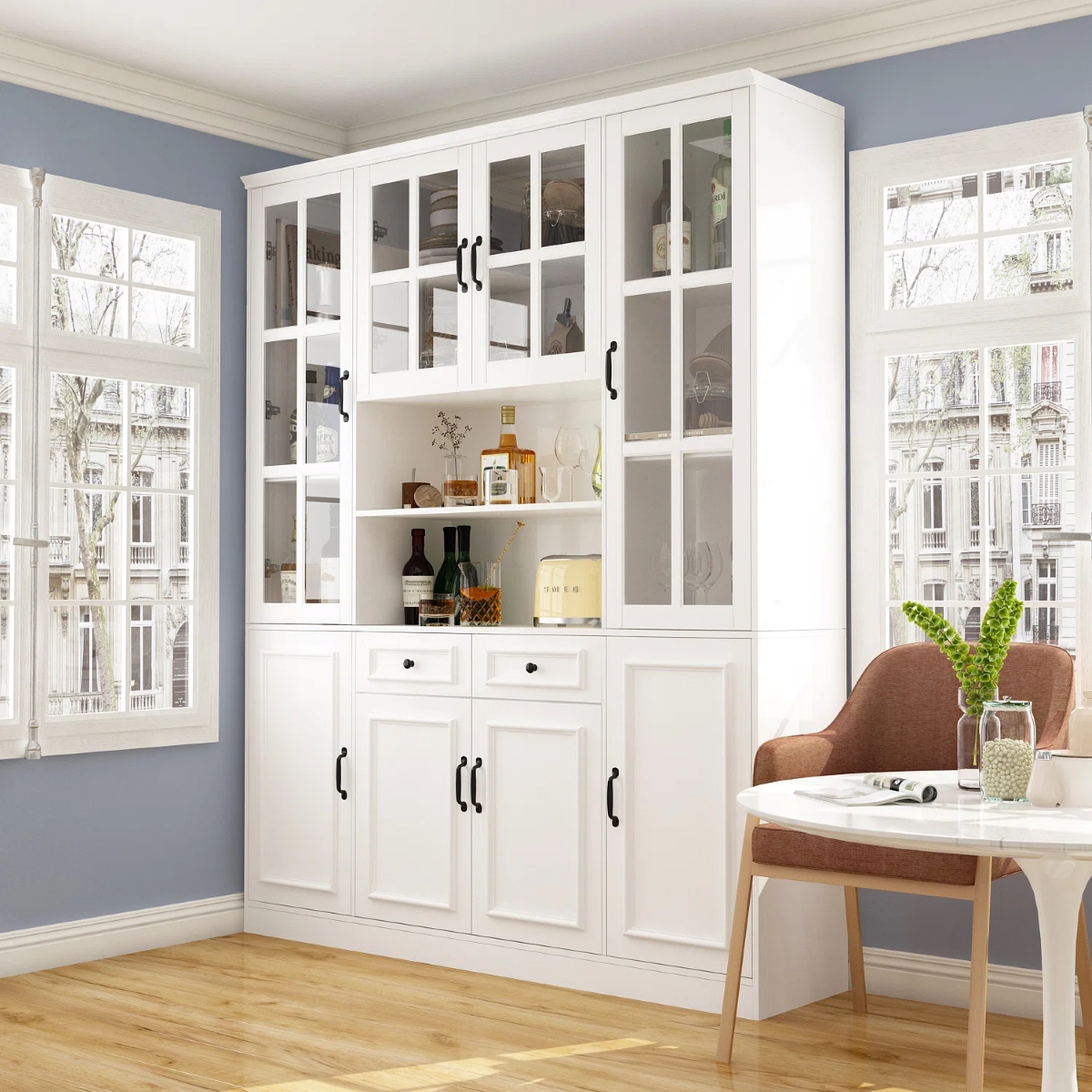
Tall Cabinet Height, Depth, and Width
Tall cabinets are generally used for pantries or storing large items like mixers, griddles, vacuums, ironing boards, and other large devices. They make excellent end caps to banks of cabinets, anchoring a kitchen design nicely. And while the sky (or ceiling) is the limit on their size, there are some standard sizes that apply to these taller units.
Standard Tall Cabinet Height
Standard tall cabinet height is usually 7 or 8 feet (84 to 96 inches). The important part to remember about this height is that it should either be taller than the top height of the upper cabinets or perfectly matched to the top height for the design to look right.
For example, a 54-inch upper cabinet height in a standard sized-room pairs well with cabinets that do not exceed 30 inches in height. If they do, they’ll be taller than the tall cabinet, which would look out of place in most designs.
Standard Tall Cabinet Depth
Standard tall cabinet depth will usually match the base cabinets, which is typically 24 inches. However, 12-inch depths are not uncommon for tall cabinets, as they can be ideal for cleaning supplies like brooms and vacuums, work as a pantry, or even function as a laundry station in kitchens with washers and dryers.
Standard Tall Cabinet Width
Tall cabinets’ standard sizes are usually 12, 24, and 36 inches, though 18-inch-tall cabinets are not unheard of. They don’t typically get much larger than 36 inches because they can be so large that they look out of balance. Thirty-six inches is about as wide as most designs will permit, otherwise the cabinet will draw the eye too much and detract from the well-designed space.
RELATED: What Is the Cost of Kitchen Cabinets?
FAQ About Kitchen Cabinet Sizes
There’s a lot to keep track when planning cabinets for a kitchen remodel, and there may be a few new questions popping up. The following may help, as they are answers to some common questions about cabinet sizes.
Q. What is the standard kitchen cabinet depth?
The standard kitchen cabinet depth for lower cabinets is 24 inches. This provides plenty of workspace while also allowing the user to easily reach items at the back of the counter. The standard upper cabinet depth is 12 inches, which keeps the user from bumping their head while working at the counter.
Q. What is the standard distance between the countertop and upper cabinets?
Generally speaking, the standard distance between the countertop and the upper cabinets is 18 inches. This allows for coffee pot and stand mixer storage under the cabinets, but it also keeps everything that’s inside the upper cabinet within comfortable reach. That said, accessibility is important and if folks need lower upper cabinets, that’s perfectly acceptable as well.
Q. What is the standard kitchen counter depth?
Standard kitchen counter depth is usually around 25 inches. This accounts for the 24-inch cabinet depth, the countertop and its overhang, as well as the backsplash at the back of the countertop.
